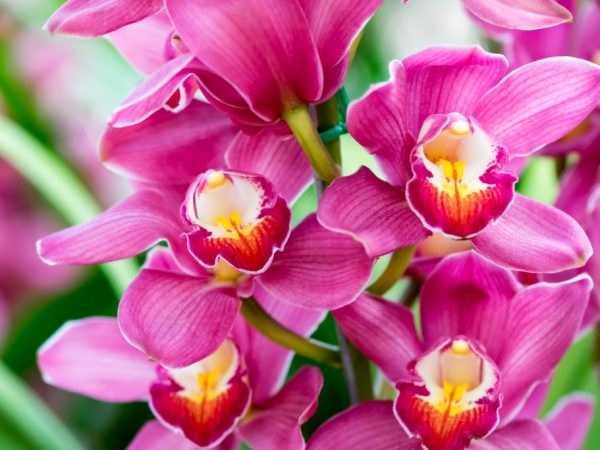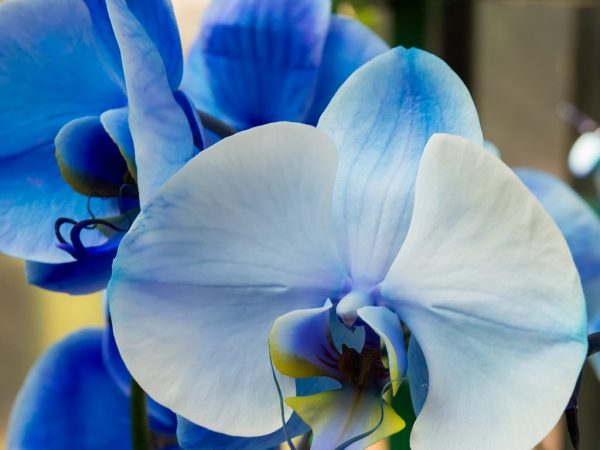Description of the Royal Orchid
The royal orchid has gained great popularity among flower growers due to its beautiful appearance. The plant reaches a height of 1 m. This is about twice the maximum height of the usual phalaenopsis species.

Description of the Royal Orchid
Description of the variety
Royal Phalaenopsis is the most common home-grown orchid species.
Phalaenopsis Royal Orchid blooms in large flowers. Their diameter reaches from 12 to 15 or even 20 cm. The peculiarities of the variety allow the plant to bloom almost all year round. The color of the flowers is varied. It ranges from white or pink to bright brindle with splashes or bright edging. The genus Wanda can also bloom with blue flowers, which will have a pleasant lilac or purple tint.
During the dormant period, Royal Orchids have massive leaves. Their size exceeds the leaves of standard varieties by 1.5 times.
Growing
The royal orchid is somewhat more difficult to grow than the regular Phalaenopsis species. However, caring for any variety of this flower at home is based on the same rules.
The Wanda Royal Orchid is planted in the soil in two ways. A shoot of a flower or seeds is used as a planting material.
Seed planting
The key to a successful orchid planting using seeds is correctly harvested and high-quality seed material. It is not easy to collect seeds at home.
The algorithm for collecting and processing seed material is as follows:
- For the ovary of several capsules containing seeds, Phalaenopsis Royal must be pollinated. However, pollination does not guarantee the formation of the desired capsule.
- The optimal condition is the use of a special Knudson nutrient medium. In the absence of it, the use of leafy land or marsh moss is assumed.
- When germinating the seeds of the Royal Phalaenopsis orchid, it is important to observe the correct temperature regime. The recommended temperature is between 22⁰ and 33⁰.
High-quality seed material can be obtained in a specially equipped laboratory. For this reason, flower growers often order Royal Phalaenopsis seeds in the countries of the East.
Planting sprouts
This type of reproduction consists in replanting the separated shoots of the plant, which are often called babies. When using this method, it is important to properly separate the sprout and plant it according to the guidelines and guidelines.
For the reproduction of Phalaenopsis, lateral shoots are used, which have already managed to take root. In this case, the root system is direct evidence that the sprout is able to obtain nutrients from the soil without the help of the mother plant.
For the correct separation and planting of the sprout, it is important to observe the following tips:
- The baby is cut with a part of the peduncle (about 1 cm).
- The cut sites on the sprout and the mother plant are dried for 30 minutes, after which they are sprinkled with cinnamon or crushed coal.
- The shoot is transplanted into a transparent plastic pot, making holes in the bottom.
- The orchid sprout is placed in the middle of the pot, with the root collar level with the edge of the container.
- The roots are carefully distributed over the soil, without ramming it.
- The transplanted baby is watered a couple of days after planting in a pot.
The mother plant is watered 5-6 days after the baby is separated. An adult plant can withstand this time without moisture. The cut sites will be completely overgrown during this period, and the flower will not be susceptible to infections.
Care

Very beautiful blue orchid
White Wanda and its blue varieties will grow and delight their owner with beautiful moth-like flowers when properly cared for.
Climatic conditions
The primary task of the grower is to provide the flowers with a microclimate acceptable for their life. Without this, all efforts will go in vain, and cultivation will not give any result.
Caring for a representative of the flora includes creating the following climate conditions:
- Maintain air temperature within 22-24С. For the growth and flowering of the Vanda genus, the temperature is raised by 2-3⁰С.
- When the flower enters the dormant period, the temperature is reduced by 6-8⁰С.
- Maintain high humidity levels. Spraying or installing a fountain or a container filled with water next to a green pet will help.
- Provide bright, diffused light from the sun's rays.
In winter, the plant is usually rearranged from the west to the south. Also in winter, flower growers provide him with additional lighting through lamps.
Watering and feeding
Keeping to a watering schedule and adding fertilizer is also important for growing a Royal Orchid. Maintaining the proper condition of the substrate and ensuring the supply of nutrients and nutrients will help you get a healthy plant that will bloom profusely.
Watering should be done in moderation. It is important to avoid stagnant liquid in the pot pan. It is also important to keep water out of the outlet when watering. One of the ways to supply the liquid is to immerse the container in water or a fertilizer solution.
Fertilize the substrate every month. Most often, special fertilizer complexes are used for orchids. Medium concentration of additives is usually used. In the summer, the dose is increased.
Diseases and pests
The plant should be taken care of, protecting it from the attacks of diseases and harmful organisms. Otherwise, the Royal Orchid dies.
Pests rarely cause flower problems. The only threat is the spider mite. It is possible to overcome it with the standard method - wash the flower with soapy water or treat it with a fungicide.
Members of the Wanda clan are more vulnerable to disease. Most often, it is affected by the following disease-causing processes:
- More atrophied than parts of the trunk.
- The appearance of cracks in the leaves.
- Fungal infection.
- The appearance of annular spots on the foliage.
- Getting a heat burn.
At the moment, most of the diseases are not amenable to treatment. Fighting is possible only with fungal infections. For this, Phalaenopsis is disinfected and the plant is treated with a fungicide.
Conclusion
The process of caring for the Royal Orchid is quite laborious, however, following a number of available recommendations and tips will not only allow you to enjoy beautiful flowers, but also increase their population through reproduction.

